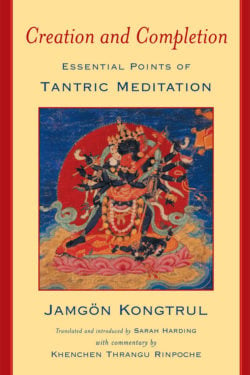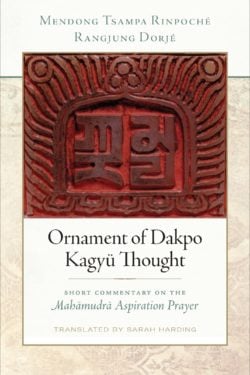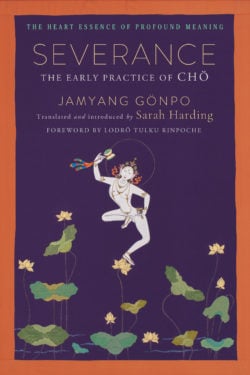Sarah Harding

Sarah Harding has been studying and practicing Buddhism since 1974, and has been teaching and translating since completing a three-year retreat in 1980 under the guidance of Kyabjé Kalu Rinpoché. She was associate professor at Naropa University for twenty-five years in Boulder, Colorado, where she currently resides, and has been a fellow of the Tsadra Foundation since 2000. She specializes in literature with a focus on tantric practice. Her publications include Creation and Completion; The Treasury of Knowledge: Esoteric Instructions; Niguma, Lady of Illusion; two volumes on Chö and Shijé from The Treasury of Precious Instructions; Four Tibetan Lineages: Core Teachings of Pacification, Severance, Shangpa Kagyü, and Bodong; and Ornament of Dakpo Kagyü Thought: Short Commentary on the Mahāmudrā Aspiration Prayer.
Books, Courses & Podcasts
Creation and Completion
Creation and Completion represents some of the most profound teachings of Jamgön Kongtrul (1813-99), one of the true spiritual and literary giants of Tibetan history. Though brief, it offers a lifetime of advice for all who wish to engage in-and deepen-the practice of tantric Buddhist meditation.
The original text, beautifully translated and introduced by Sarah Harding, is further brought to life by an in-depth commentary by the contemporary master Thrangu Rinpoche. Key Tibetan Buddhist fundamentals are quickly made clear, so that the reader may confidently enter into tantra’s oft-misunderstood “creation” and “completion” stages.
In the creation stage, practitioners visualize themselves in the form of buddhas and other enlightened beings in order to break down their ordinary concepts of themselves and the world around them. This meditation practice prepares the mind for engaging in the completion stage, where one has a direct encounter with the ultimate nature of mind and reality.
Four Tibetan Lineages
The newest translation from master translator Sarah Harding.
Drawing primarily from the Pacification, Severance, Shangpa Kagyü, and Bodongpa traditions, Four Tibetan Lineages presents some of Tibet’s most transformative yet lesser-known teachings on meditative practice. Most works in this volume are drawn from a Tibetan anthology known as the Treasury of Precious Instructions compiled by Jamgön Kongtrul Lodrö Thayé (1813–1900). A vast preservation project, this anthology reflects Kongtrul’s attempt to rescue rare teachings from disappearing. By foregrounding the teachings of masters like Khedrup Khyungpo Naljor (d. 1135), Dampa Sangyé (d. 1117), Machik Labdrön (1031/55–1126/50), Jonang Tāranātha (1575–1634), and Jamyang Khyentsé Wangpo (1820–92), this volume extends Jamgön Kongtrul’s preservation efforts into the modern world.
Learn more about the Library of Tibetan Classics
Learn about becoming a benefactor of the Library of Tibetan Classics
Ornament of Dakpo Kagyü Thought
The Mahāmudrā Aspiration Prayer is one of the most brilliant and popular compositions on mahāmudrā. Written in easygoing nine-meter verse, this heartfelt prayer by Rangjung Dorjé lends itself to chanting and ritualized group prayer and is at the same time intricately organized into the most profound and thorough exposition of mahāmudrā, the pinnacle of practice in the Kagyü school of Tibetan Buddhism. The commentary on the prayer by Mendong Tsampa Rinpoché brilliantly illuminates its subtleties, making it even more accessible for the reader, and students and teachers alike will appreciate the inclusion of the Tibetan script on facing pages of the prayer and commentary.
This is a text for encouraging study, for inspiring practice, and for the awakening of the world.
Severance
An ancient Buddhist guide to confronting difficult circumstances and letting go of clinging to the ego.
Severance, or Cho, is the Tibetan Buddhist practice of facing one’s fears. In three remarkable texts lucidly translated and introduced by Sarah Harding, the thirteenth-century Severance master Jamyang Gönpo shares advice that goes straight to the heart of both understanding and experiencing the practice. For hundreds of years, Severance has remained essentially an instruction on coping with stressful situations that provoke fear and, beyond that, a way to actively seek out such circumstances in order to test one’s realization of perfect wisdom.
The single overall directive of the first two texts in this volume—the Heart Essence of Profound Meaning root verses and their commentary, The Big General Guide to Severance—is to seek out and directly confront difficult circumstances. Here, these difficulties are often anxieties related to spirits in the dark of night in haunted places. This practice acts as a means to recognize emptiness—the lack of intrinsic existence of all phenomena—as well as a testing ground of one’s former realizations and studies of that emptiness from the Perfection of Wisdom. The texts are notable for their lack of instruction on ritualized Severance involving body sacrifice, which later works emphasize; in these texts, the heart of Severance is letting go of clinging to the self and reification of existence. And as Jamyang Gonpo was just a generation removed from Machik Labdron, the main progenitor of Severance, his methods seem to be closest to her actual teachings.
The third translation in this volume, The Seven-Day Severance Retreat Experiential Guide, is a very concise and precise instruction on putting the main intentions of the teachings into practice in the setting of a one-week retreat. The instructions are striking in that they contain no rituals, visualizations, deities, instruments, or liturgies. Jamyang Gönpo shows us how to turn our attention to the very mind of this person who is experiencing fear and the object of that fear—whether fear about demons or sickness or suffering—to see them for what they are. In doing so, we find that joys and sorrows, highs and lows, powers of gods and demons, and demonic obstacles are all mind made.




